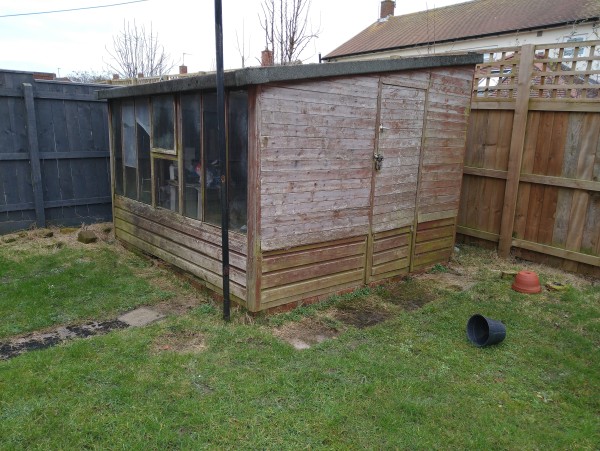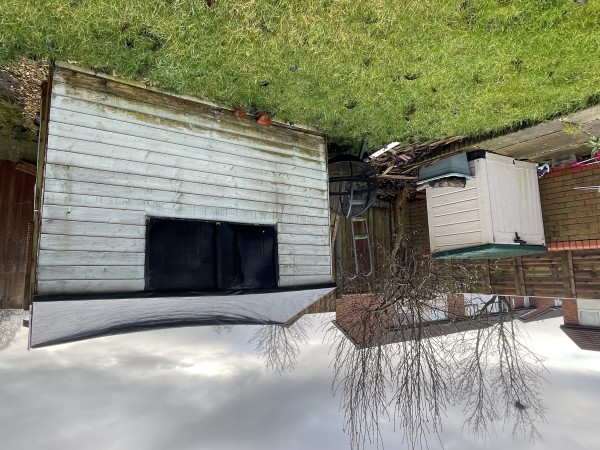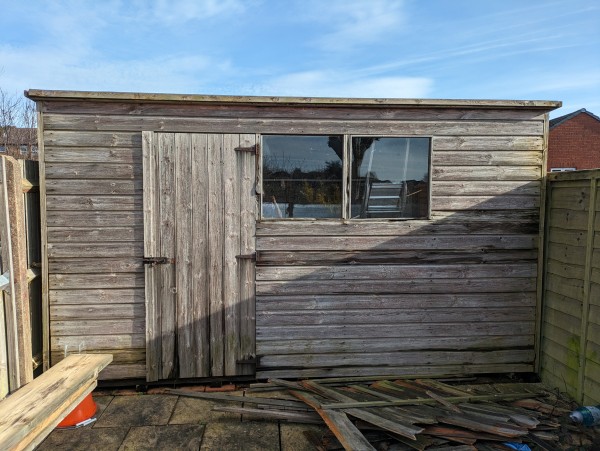Shed Dismantling & Removal Service: Comprehensive Guide
 Edited by Ali Lijee
Edited by Ali Lijee
Looking to dispose of an old garden shed, toolshed, or granny annexe from your property? The man and van teams listed on Rubbish.com provide full shed dismantling and removal services for residential properties across the UK. We’ve licensed waste carriers near you that can help take apart your shed, sort the waste and haul it away for recycling and disposal at the council tip at competitive prices. No need to fuss or worry about how to get rid of the bulky builder’s waste from demolishing your old toolshed, metal shed, or brick shed - let our experienced member partners handle all of the labour and leave your garden clean and clutter-free.
We will dismantle, remove & dispose of your shed
Table of contents:
- Shed dismantling & removal services UK
- Shed clearance service near you
- Gallery of sheds we have removed
- Shed removal: questions people commonly ask
Shed dismantling & removal services UK
Whether you’re looking to get rid of an old and unwanted shed from your garden to create a cleaner, more beautiful garden, or you want to upgrade your shed to a better and more modern replacement shed, our rubbish removal partners can help get the job done quickly and at affordable prices.
We operate nationwide across the UK with licensed waste carriers that provide comprehensive shed dismantling and removal services, including the collection and environmentally friendly disposal of all builder’s waste such as metal, timber, plastic, and concrete.
Shed clearance service near you
Many homeowners in the UK have sheds for storing away garden tools and equipment, additional seasonal storage for patio furniture or decor, or even as a garden conservatory or for living, e.g. a granny annexe. However you use your shed, there may come a time when you no longer need or want it on your property.
Dismantling and removing your shed can be laborious and complex, depending on the size, weight, and materials used to construct your shed. However, the licensed waste carriers on this site can assist with the dismantling and clearance of your shed, leaving your garden pristine and more spacious.
Gallery of sheds we have removed
Shed removal: questions people commonly ask
How much does it cost to dismantle a shed in the UK?
A shed in the UK can range from around £75 to £150 or more in shed demolition costs depending on the size of the shed and the amount of labour required. Rubbish removal companies will also charge around £75 to £300 or more to haul away the waste.
Smaller sheds tend to cost less to dismantle than larger sheds, and sheds with rotted wood may be easier and faster to dismantle.
How do I get rid of a shed in the UK?
Most councils in the UK offer bulky waste collection, but sheds are often not accepted. To get rid of a shed, it must first be dismantled and all waste must be disposed of at an appropriate Household Waste Recycling Centre (HWRC) or ‘local tip.’
You can dismantle and dispose of your shed yourself or hire a man and van rubbish removal team to do the job on your behalf. Keep in mind that you may need to separate recyclable waste such as nails and screws from any timber as well as remediate the ground afterwards.
How big can a shed be without planning permission in the UK?
Most councils in the UK require planning permission to erect a shed in a garden, unless the shed:
- Does not exceed 2.5 metres in height
- Does not occupy 50% or more of the space around your property
- Does not exceed 15 square metres in area
There are additional criteria, so please consult your local council for guidance on planning permissions for sheds and outhouses on your property.
What are the laws on sheds in the UK?
Sheds, greenhouses, and other outbuildings in the UK are subject to legislation set forth in The Town and Country Planning (General Permitted Development) (England) Order 2015. All sheds built on properties in the UK must comply with the law and the property owner must obtain relevant planning permissions unless the shed meets specific criteria.
The planning permission is obtained from your local council and may approve or deny the permission to erect a shed or outbuilding on your property.
Can my neighbour complain about my shed?
If your shed causes a nuisance to a neighbour, they may be able to complain and take action against you if your shed is found to cause a nuisance to them. Neighbours have a right to light and can litigate if your shed obstructs their view, if the shed’s roof is diverting water onto your property, or if the shed is located on or too close to the fence or property line.
Neighbours can complain and make a claim against you, especially if the shed is found to be in violation of planning permissions and laws for sheds and outbuildings. The best solution is to obtain and abide by planning permissions where required, attempt to resolve the matter in person with the neighbour, and if all else fails obtain legal counsel.
Can you move a shed yourself?
It may be possible to move your shed yourself if it is relatively small or medium-sized and you are working with reasonably smooth ground. Lighter sheds can often be moved with no more than a dolly or a pallet jack, so long as safety is prioritised.
Heavier sheds often require heavy machinery such as skid steers to relocate and in some cases, the shed may need to be disassembled in order to be moved.
How close can a shed be to a fence in the UK?
Generally sheds should be located at least 1.5 metres away from the neighbour’s fence in order to ensure that rainfall does not pour onto the neighbour’s property and to avoid nuisances. Some councils require a minimum distance of 2.0 metres in order to build a shed without planning permissions.
It is generally always best to consult with your neighbour to resolve any potential disputes before building your shed as well as to abide by building regulations for sheds, regardless of whether or not planning permissions are required.
What size shed can I put in my garden without planning permission?
Sheds can typically be no larger than 15 square metres in floor area to be erected in a garden without planning permission from a local council. Moreover, the shed should not be used as a residence for sleeping purposes.
There are many other criteria for sheds to be erected in a garden without planning permission and it is highly recommended to consult with your local council to ensure that your shed is compliant.
How hard is it to move a shed?
Small and medium-sized sheds may be relatively simple to move, whereas large sheds may be far more complex and require more labour and machinery. For smaller sheds, it may be possible to move it with two people and a dolly or pallet skid; larger sheds may require more labour, time, and heavier machinery such as skid steers to move safely.
Moving a shed to or from a property will also require a flatbed lorry, or if taken for disposal, a suitable rubbish removal vehicle capable of safely hauling and disposing of the shed’s materials.
How do I move my own shed?
Moving your shed on your property generally requires clearing out the contents of the shed, preparing the ground in the area where you want to move the shed, checking the framing for signs of rot or damage that could fall apart when the shed is moved, then using the right amount of labour and equipment to physically move the shed.
For small to medium-sized sheds, a dolly or pallet jack may suffice or you may be able to pull the shed with rope over PVC rollers. For large and heavy sheds, consider hiring heavy machinery such as a skid steer to safely move the shed.
Can I live in a shed on my own land in the UK?
You are permitted to live in a shed on your property in the UK provided that the shed has all planning permissions and has sufficient amenities to ensure safety and habitability for residential use.
Typically referred to as granny annexes (or granny flats), residential-use sheds must have adequate insulation, ventilation, and structural integrity, meet fire regulations, and use appropriate plumbing and/or electrical installations as required.
It is becoming increasingly common for many in the UK to live in a shed or granny annexe, although it is important to have all planning permissions and to abide by building regulations. Living in a shed illegally in the UK can carry penalties including eviction or even demolition of the shed.
Can you move a shed without dismantling?
Small and light sheds can often be moved without dismantling the shed. These sheds can be moved either by lifting the shed with a furniture dolly or by pulling the shed with sturdy rope over PVC rollers, for example. Heavier sheds may require skid steers or other heavy machinery to safely move.
If the shed has significant signs of rotting or damage to its framing, the shed may fall apart during the move. The shed may need to be dismantled before being moved or disposed of.
To haul sheds over long distances, a flatbed lorry may be required in order to safely transport the shed.
Can I turn my shed into a bedroom in the UK?
Sheds in the UK can be turned into bedrooms and used for residential purposes so long as the property owner obtains all relevant planning permissions. Government regulations require planning consent and permission for any garden building intended for the use of sleeping in.
Granny annexes are becoming increasingly popular in the UK, but it is essential to ensure that your shed or granny annexe is fully compliant with building regulations for safety and habitability as well as being legally granted planning consent.
Is it cheaper to repair or replace a shed?
It is often more convenient and cost-effective to repair a shed than it is to replace it, although there are many variables that should be considered before making a choice. If a shed is noticeably rotting or has signs of significant damage to the framing, replacement may be safer and more cost-effective on the long term. For minor damage or gradual wear and tear, repairs tend to be more affordable.
Can you repair a rotting shed?
Rotting sheds can often be repaired by replacing all rotted timber with new treated timber. Rotten framing may be more complex to repair, particularly if the rotted timber is load-bearing, e.g. holding up the shed’s roof. Rotten roof panels/tiles or framing may be easier and safer to repair.
How do you remove a brick shed?
Removing a brick shed typically requires full dismantling and demolition of the shed. The roof and façade masonry will need to be demolished, followed by the framing. Most brick sheds have concrete foundations that will then need to be demolished. Demolition waste will need to be sorted and transported to the tip since many councils do not accept DIY or builder’s waste for collection.
Brick shed removal costs can vary from around £500 to £800 or more, depending on labour required and the size of the shed. The process of dismantling and hauling away the waste from a brick shed can take anywhere from a day to a few days.
Can the council make me take down my shed?
Your local council can order you to take down your shed if it does not have planning consent or permissions when it should, if your neighbour takes legal action and the court orders you to take it down, or if the shed is not used for its intended purpose such as illegally being used as a residence.
There are many ways to prevent this from happening, but they most involve abiding by the law and attempting to negotiate with neighbours to come to a reasonable compromise.
Can I burn an old shed?
Old wooden sheds can be burnt so long as the timber is untreated and hasn’t been painted. It may be cheaper to burn an old wooden shed than to have the timber waste hauled away, but keep in mind that the fire can cause a nuisance to neighbours and all fires should be controlled.
Wooden sheds with treated and/or painted timber cannot be burnt since the paint/treatment can create toxic fumes. Keep in mind that some very old sheds may also contain lead-based paint which has been banned in the UK since 1992, so refrain from burning wooden sheds manufactured or painted before that year.
Can I sell my garden shed?
You can sell your shed using online marketplaces or through your community, so long as you are honest about the shed’s condition and negotiate the removal and safe transport of the shed. Accompany your listing with photographs of the shed’s interior and exterior as well as its dimensions.
Do not sell sheds that may contain asbestos or that have been built or painted prior to 1992 as they could contain lead-based paint which is now banned in the UK.
What is the life expectancy of a shed?
Most sheds in the UK can last from around 5 to 30 or more years, depending on the type of shed and its materials as well as how well maintained it is. Wooden sheds, perhaps the most common in the UK, can last for around 25 years. Plastic sheds may last for around 5-10 years. Vinyl sheds may last around 30 years or longer. Metal and brick sheds may last for well over 30 years if well maintained.

 GET QUOTES
GET QUOTES

